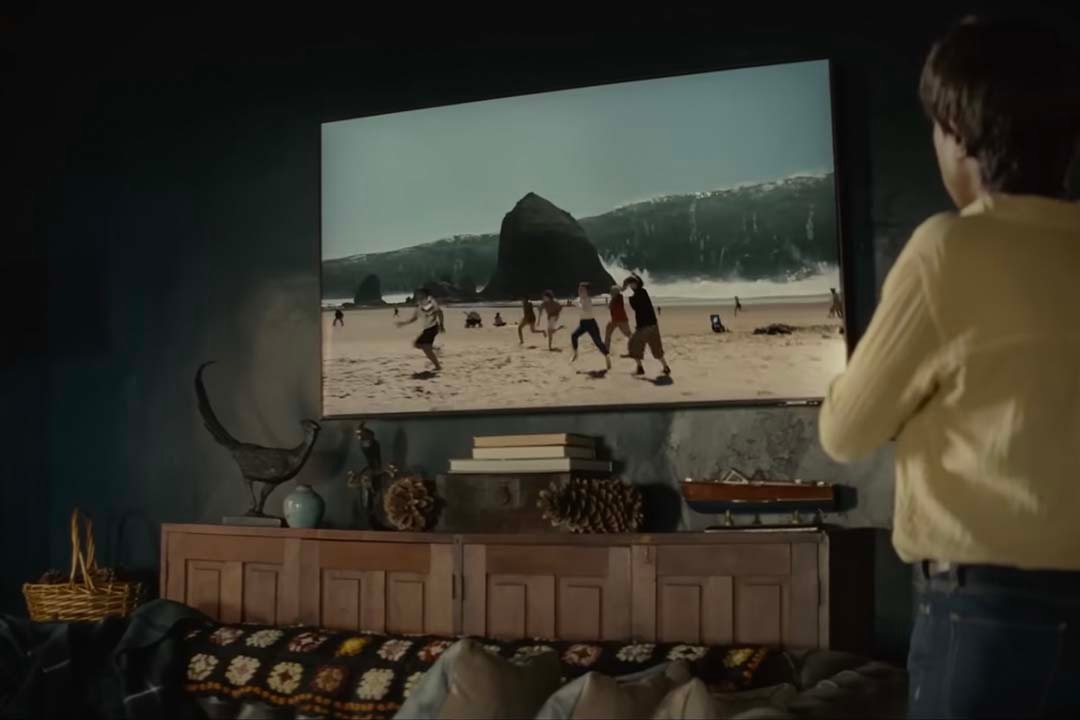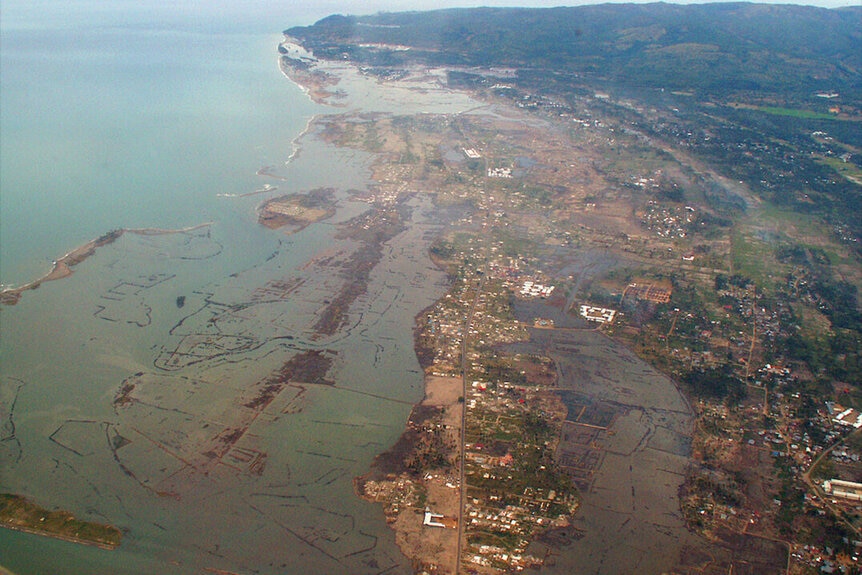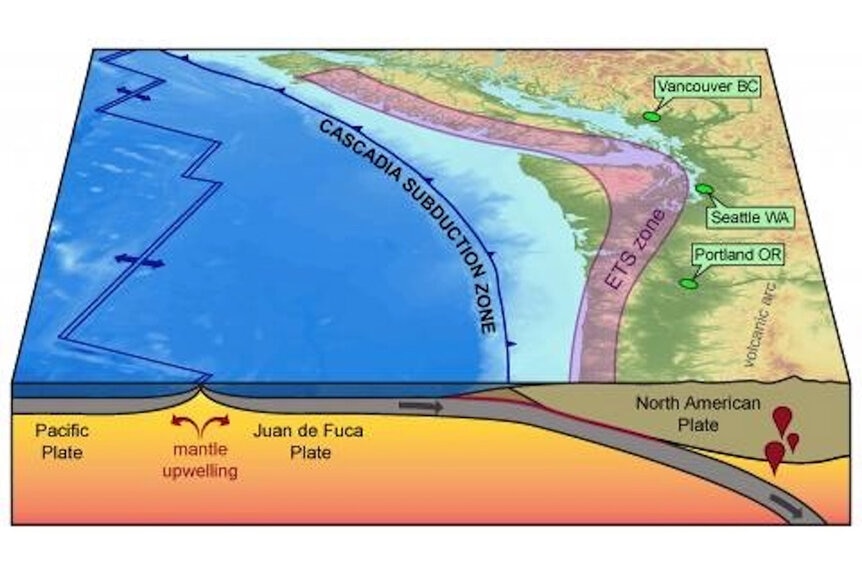Create a free profile to get unlimited access to exclusive videos, sweepstakes, and more!
Could 'Knock at the Cabin's Pacific Northwest tsunami really happen?
Is there anywhere safe from gigantic killer waves?

M. Night Shyamalan’s apocalyptic horror Knock at the Cabin, based on the Paul Tremblay novel The Cabin at the End of the World, hit theaters Feb. 3. The story opens on Wen, a young girl on vacation with her parents Eric and Andrew, at a remote cabin in Pennsylvania. It’s an idyllic scenario but one which quickly turns south.
**SPOILER WARNING: We’re going to talk about the setup and early events of the story in the coming paragraphs. Proceed with caution!**
While Wen is out catching grasshoppers in the yard, she is approached by a friendly but unfamiliar man named Leonard (Dave Bautista), who tell Wen he needs her help to save the world. When three others join Leonard with violent-looking makeshift weapons, they force their way inside of the house, and present Wen and her parents with a choice: They must willingly sacrifice one of their own or else the world will end.
RELATED: Where ‘Knock at the Cabin’ ranks on the Shyamalan movie ending bleak-o-meter
Their skepticism can be forgiven. Any of us, in the same scenario, would doubt what we were hearing. Scenarios like that just don’t exist and even if they did, they don’t fall on the shoulders of ordinary people. Unless they do. After Eric and Andrew refuse to make a choice, the family is shown the consequences of their resistance. A massive tsunami has struck the Pacific coast of the United States, killing an untold number of people. That was the cost of their first refusal and, unless they make a choice, it won’t be the last.
TSUNAMIS
The world is no stranger to disaster. Earthquakes, volcanoes, tornadoes, and hurricanes regularly tear across the planet, taking infrastructure and human lives with them. And sometimes those disasters travel in groups. An earthquake, for instance, might trigger a volcanic eruption, compounding the devastation before anyone can pick themselves up off the ground. Worse, earthquakes and volcanoes (not to mention asteroid impacts) can cause disturbances in the ocean, resulting in massive and destructive waves. We call those tsunamis.
These catastrophic waves can travel far inland, covering miles of typically dry landscape in a temporary ocean and they happen more often than you might realize. There have been more than a dozen destructive tsunamis recorded since the turn of the century, with most of them impacting Asia, South America, or the Pacific Islands, and they can be deadly.
RELATED: How 'Knock at the Cabin's ending changed from the book, 'The Cabin at the End of the World'
The deadliest tsunami on record occurred on the morning after Christmas in 2004. At 7:59 local time an oceanic plate off the coast of Sumatra hit a continental plate and slid beneath it in a process known as subduction. The shift triggered an earthquake with magnitude 9.2, the third largest earthquake ever recorded by a seismograph, and shook for between 8 and 10 minutes, triggering additional earthquakes as far away as Alaska. The estimated energy released during the quake was the equivalent of 23,000 atomic bombs and was enough to shimmy the entire planet by about a centimeter.
The quake also caused massive waves to form in the Indian Ocean. They radiated out from the earthquake’s epicenter, striking at least 11 countries. Within 20 minutes of the earthquake, the waves had reached Banda Aceh on the northern tip of Sumatra. Waves roughly 100 feet high swept over the city, killing an estimated 100,000 people. Over the next several hours waves hit other shores. By the time the water receded more than 230,000 people had been killed.
That was certainly an apocalypse level event for the people who experienced it. It must have felt like the world was ending, but it’s not typically the sort of thing which impacts the Pacific Northwest. Although, that may just be a matter of time.
PNW CASCADIA SUBDUCTION ZONE
The notion that tsunamis don’t hit the Pacific Northwest is likely the result of some recency bias. There haven’t been any large destructive tsunamis in the region in living memory and that might have given residents of the area a false sense of security. On a long enough timescale that is bound to change.
The Pacific Northwest is home to the Cascadia Subduction Zone. That’s where the Juan de Fuca oceanic plate meets up with the North American continental plate. It’s a geological rendezvous not unlike what’s happening in the Indian Ocean. There was a 7.2-magnitude quake in the southernmost part of the subduction zone in 1992 which caused damage in Northern California as well as a minor and non-destructive tsunami. The last great quake in the region occurred in January of 1700, generating waves which reached all the way to Japan, but there hasn’t been a notable shakeup in centuries.
It's believed that the average interval between massive quakes in the Cascadia Subduction Zone is roughly 400 – 500 years, which might mean we’re pretty close to due. Of course, natural disasters don’t work on a schedule, so don’t mark your calendars just yet. According to the USGS, there is mounting evidence that the region is perched between major earthquake events.
While most people in the region might not think much about tsunamis, governments in California, Oregon, and Washington have collaborated with federal entities to quantify their tsunami risk and design geological hazard maps for their respective geographical areas. They map out where and how a tsunami would strike under different quake conditions, how to prepare, and evacuation plans.
If you happen to live on the west coast of the United States, you might want to check your local resources and plan for the eventuality. A deadly tsunami will hit the Pacific Northwest eventually. It’s not a question of if, but when, no apocalyptic harbingers needed.
Knock at the Cabin is now playing in theaters everywhere. Click here to purchase tickets.




























